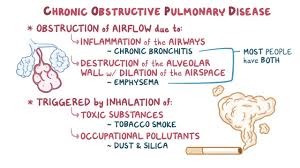
Chronic obstructive pulmonary disease (COPD) is a common lung disease causing restricted airflow and breathing problems. It is sometimes called emphysema or chronic bronchitis.
In people with COPD, the lungs can get damaged or clogged with phlegm. Symptoms include cough, sometimes with phlegm, difficulty breathing, wheezing and tiredness.
Smoking and air pollution are the most common causes of COPD. People with COPD are at higher risk of other health problems.
COPD is not curable but symptoms can improve if one avoids smoking and exposure to air pollution and gets vaccines to prevent infections. It can also be treated with medicines, oxygen and pulmonary rehabilitation.
The most common symptoms of COPD are difficulty breathing, chronic cough (sometimes with phlegm) and feeling tired.
COPD symptoms can get worse quickly. These are called flare-ups. These usually last for a few days and often require additional medicine.
People with COPD also have a higher risk for other health problems. These include:
Common symptoms of COPD develop from mid-life onwards. As COPD progresses, people find it more difficult to carry out their normal daily activities, often due to breathlessness. There may be a considerable financial burden due to limitation of workplace and home productivity, and costs of medical treatment.
COPD is sometimes called emphysema or chronic bronchitis. Emphysema usually refers to destruction of the tiny air sacs at the end of the airways in the lungs. Chronic bronchitis refers to a chronic cough with the production of phlegm resulting from inflammation in the airways. COPD and asthma share common symptoms (cough, wheeze and difficulty breathing) and people may have both conditions.
Several processes can cause the airways to become narrow and lead to COPD. There may be destruction of parts of the lung, mucus blocking the airways, and inflammation and swelling of the airway lining.
COPD develops gradually over time, often resulting from a combination of risk factors:
COPD should be suspected if a person has typical symptoms, and the diagnosis confirmed by a breathing test called spirometry, which measures how the lungs are working. In low- and middle-income countries, spirometry is often not available and so the diagnosis may be missed.
COPD isn’t curable, but it can get better by not smoking, avoiding air pollution and getting vaccines. It can be treated with medicines, oxygen and pulmonary rehabilitation.
There are several treatments available for COPD.
Inhaled medicines that open and reduce swelling in the airways are the main treatments.